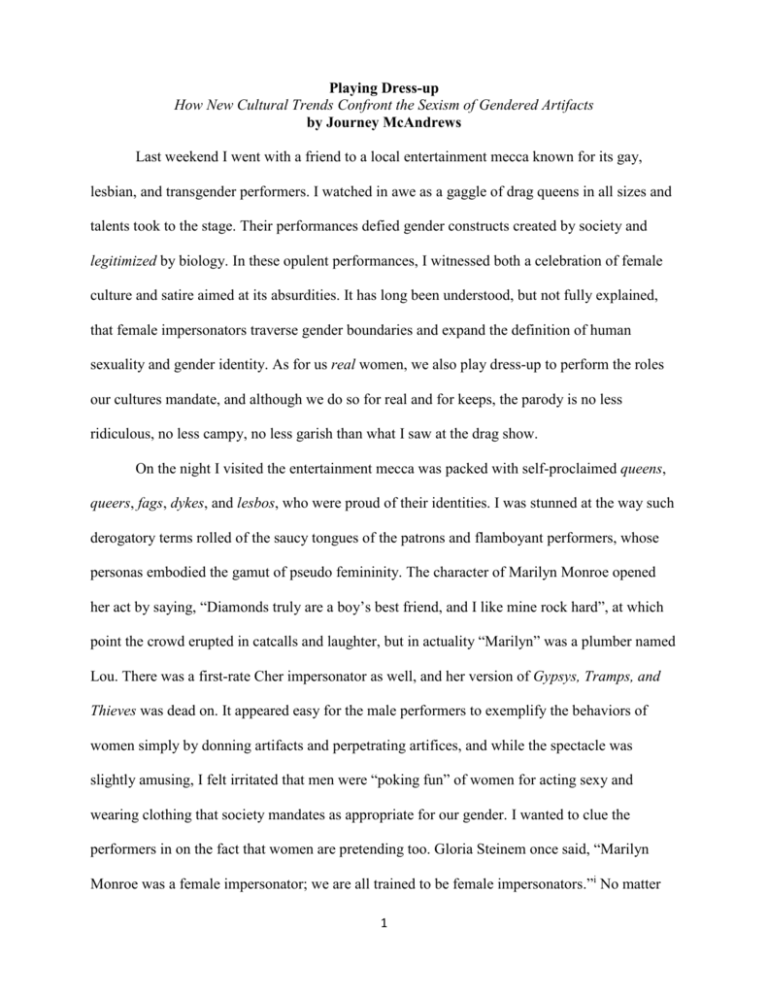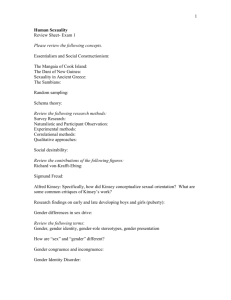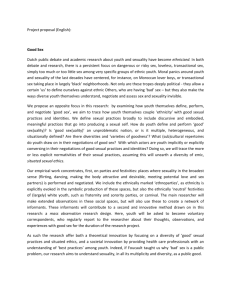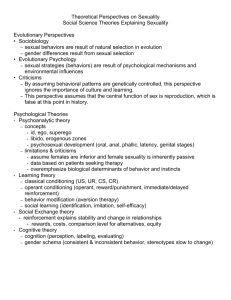
Playing Dress-up
How New Cultural Trends Confront the Sexism of Gendered Artifacts
by Journey McAndrews
Last weekend I went with a friend to a local entertainment mecca known for its gay,
lesbian, and transgender performers. I watched in awe as a gaggle of drag queens in all sizes and
talents took to the stage. Their performances defied gender constructs created by society and
legitimized by biology. In these opulent performances, I witnessed both a celebration of female
culture and satire aimed at its absurdities. It has long been understood, but not fully explained,
that female impersonators traverse gender boundaries and expand the definition of human
sexuality and gender identity. As for us real women, we also play dress-up to perform the roles
our cultures mandate, and although we do so for real and for keeps, the parody is no less
ridiculous, no less campy, no less garish than what I saw at the drag show.
On the night I visited the entertainment mecca was packed with self-proclaimed queens,
queers, fags, dykes, and lesbos, who were proud of their identities. I was stunned at the way such
derogatory terms rolled of the saucy tongues of the patrons and flamboyant performers, whose
personas embodied the gamut of pseudo femininity. The character of Marilyn Monroe opened
her act by saying, “Diamonds truly are a boy’s best friend, and I like mine rock hard”, at which
point the crowd erupted in catcalls and laughter, but in actuality “Marilyn” was a plumber named
Lou. There was a first-rate Cher impersonator as well, and her version of Gypsys, Tramps, and
Thieves was dead on. It appeared easy for the male performers to exemplify the behaviors of
women simply by donning artifacts and perpetrating artifices, and while the spectacle was
slightly amusing, I felt irritated that men were “poking fun” of women for acting sexy and
wearing clothing that society mandates as appropriate for our gender. I wanted to clue the
performers in on the fact that women are pretending too. Gloria Steinem once said, “Marilyn
Monroe was a female impersonator; we are all trained to be female impersonators.”i No matter
1
our culture or geographic location, “we are born into a gendered society that guides our
understanding of gender and shapes our personal gendered identities.”ii In a flash of color and
audacity I could never muster in a million years, drag queens strutted across the stage decked out
in an array of dresses that would make any fashionista envious. Many of the performers had gone
under the knife to complete their transformations, while a few others were still pre-op
transsexuals. Others were just everyday Joes who like to wear women’s clothing—dresses in
particular are a beloved garment of drag queens, and the same holds true for the real women they
imitate.
As I marveled at the exhibition before me, I kept wondering how drag queens, crossdressers, and transsexuals fit within the context of human sexuality. Mostly, I wondered about
how society has shaped and conditioned my sexuality. While I recognize the parody and gaiety
inherit in drag shows, I also know that artifacts are important across all cultures because they
influence “how we see ourselves and how we express the identity we create for ourselves.”iii
Suddenly my own feminine grooming rituals and habits seemed as equally absurd as what I
witnessed at the drag show. The rules society creates when it comes to sex and gender have
baffled me for years, so much so that I actively engage in experiences like going to see drag
shows just so I can learn more about sex and gender dogma, which may explain why I agreed to
spend the day at the mall with my mother.
In just over a month my parents will celebrate their thirty-ninth wedding anniversary.
When my mother called me before seven this morning I already knew what she wanted, and I
also knew I would say yes. Although my abhorrence for the mall is immeasurable, I love to
watch people and imagine their stories; therefore, I hauled myself out of bed, ran a bath, and
slowly, ever so slowly, eased into the idea of going to the mall to look for a dress. Every year my
mother insists I accompany her to the mall so she can find a dress to wear on their big night out.
2
Recalling how many times she took me shopping for dresses when I was younger—holidays,
summer gatherings, funerals, family reunions, religious ceremonies, I feel compelled by some
warped sense of duty to join her on her yearly quest. In childhood my dresses were various
shades of pink— the official color of my youth, and they had the twirl factor—one quick spin
and my dresses ballooned out in awe-inspiring circles of lace, ruffles, and fluff. Every major
event in my young life centered on acquiring a new dress, this was especially true when my
social calendar expanded to include dances, prom, homecoming, and a slew of first dates. Now I
realize that the dresses girls receive in youth are merely practice runs for the most important
dress of all—the wedding dress. Much to my mother’s frustration, my love affair with dresses
ended when I was about fifteen years old, thus I never yearned for the much sought after
wedding dress. Even today, I loathe weddings, wedding dresses, and the color pink. Is it because
an avalanche of pink dresses traumatized me in childhood? Perhaps! Or is it because I am
stubborn, strong-minded, and opinioned to the bone? Indeed!
Today, I have absolutely no interest in the smorgasbord of dresses the mall has to offer;
instead, I am on the lookout for the nearest bench or chair, just as my father would be if he had
joined us. Unlike my childhood and teenage days, I am off the hook on this shopping trip—it is
all about my mother’s special occasion, and thankfully, unlike other women who shop in packs
or pairs, when my mother shops for herself, she likes to do so alone. My mother finds true
pleasure in flying solo as she combs through rack after rack of sequins, lace, buttons, zippers,
and bows. I have come to think that when a woman wants to shop alone it is because she needs
to be the first one to find whatever it is she is looking for. Unmistakably this trip to the mall is
about “the promised change in appearance that a new dress—and only a new dress—can hold.”iv
Before she departs, my mother urges me to find something nice for myself, adding that she will
pay for it. Of course, find something nice is a twisted version of mother-ese, designed for
3
grownup daughters. It translates into, if you would fix yourself up a little, you might find a nice
man to call your own. I grew tired of shopping for first date dresses years ago, so I decide instead
to continue looking for a place to sit and wait for what is sure to be my mother’s triumphant
return.
I learned in late adolescent that within the intimate circle of women the perfect man is
always the one who does not get away, but then again, I have never been a full-fledged member
of any intimate circle of women. Even as a child, my brazen attitude towards gender made me
seem somewhat like one of the boys, and as such, males both young and old were comfortable
including me in their masculine adventures. Despite a few doo-doo heads that were cruel and
excluded me from time to time, I feel lucky to boast that I have been included in far more male
outings than most girls have, but then again, I am not like most girls. I went on fishing trips with
my father while my girlfriends and female cousins did not. I played cowboys and Indians without
having to assume the role of the cowgirl who was kidnapped and rescued. My father worked on
heavy equipment so I also spent many hours of my youth at stockyards, junkyards, and part
supply stores, and similar places other places a proper girl should not go. Back then, I could
easily wipe the grease from my face and slip into the fitting room to try on yet another dress, but
as a woman, I sometimes still feel pressed to choose a side. I began in early childhood to
transverse the narrow margin that separates the masculine and feminine worlds. I spent mornings
baking with my grandmother and evenings in the garage with my father while he overhauled
engines. I pretended to breastfeed my baby dolls and acted out war scenes with my brother and
his male friends. As an adult female, I continue to navigate both the masculine and feminine
worlds—most days I wear a white button-down men’s dress-shirt as proudly as I wear Stila lipgloss and Chanel N◦5.
4
Understandably I sometimes feel caught in the middle of these two worlds—not quite girl
enough to be a real girl, and too much of a girl to be a boy. I can play dress-up like a girl and
drink beer and tell dirty jokes like a boy, but I cannot possibly do both at the same time and still
expect men and women to accept me into their intimate circles. I must be one of the girls when I
am with the girls and one of the boys when I am with the boys. There have been times over the
years when I have had to take sides, and it is never easy, but how can I explain any of this to my
mother? How can I tell her that the perfect dress will not help me find what I am really looking
for—a world where I never have to decide which gender to pledge my allegiance to, never have
to pretend that boys will be boys and girls will be girls, where I can be myself in whatever
manifestation my identity takes. In the meantime, the reality of celebrating my parents
impending anniversary places me squarely in the narrow crevice of gender politics once again. I
do celebrate their love in its truest essence, but I do not understand the synthetic artifacts
attached to their love. This morning in the mall, it is not a dress rehearsal. It is not a drag show. It
is the story of a real woman purchasing a dress to influence a real man with her ability to
paraphrase the gender constructs of their culture. My mother is a female impersonator playing
the role she was scripted to play.
My mother’s image gets smaller and smaller as she makes her way across the length of
the mall, finally disappearing through the entrance to Macy’s. I locate a row of empty benches
that surround Victoria’s Secret and take a seat just as many men do when they come to this place
with their significant female others. The mall is still relatively quiet, but it is Sunday and the
stores have just opened. I take out the book I brought with me, a dog-eared copy of Crime and
Punishment, but I am unable to concentrate on fiction when so much reality is before me. Groups
of mall walkers pass by me. The women paired close together, talking boisterously to one
another, while the men lag behind in silence. Age has been unkind to all of their bodies, but our
5
society tends to accept aging men more readily, and reserves its harshest prejudices for women
by emphasizing our wrinkles, flabby arms, drooping derrières, protruding bellies, and sagging
breasts. I tell myself that I do not believe society’s views on the aging female body, but just for a
moment, I am afraid of growing old like these women—like my mother. The fear of aging is
double for someone like me. It is easy to not give a shit about relationships while I still have my
youth, but where do I fit if I refuse to become Prince Charming’s Cinderella? Society has clearly
defined roles for older women—caregiver, nurse/maid, grandmother, but what role will I play
after spending my life somewhere in the middle? Can I dress in men’s clothing at the nursing
home and take up needlework? Can I talk politics with the guys while powdering my nose with
the gals?
As the mall walkers disappear from sight, I turn my attention back to my immediate
surroundings. I have not shopped in a mall since the late 1990’s when I stopped keeping up with
fashion trends. My wardrobe, if you can call it that, is a hodgepodge of blended styles. These
days I mostly wear men’s button up shirts—the top two buttons always left undone, short shirts
or worn jeans, corset boots or high-heel sandals, depending on the occasion and season.
However, no matter what I put on, I always make a point to wear a black bra. Why? I guess it is
my way of protesting against another gender trauma I suffered in my youth—one far more
confusing than the plethora of pink dresses. My first bra came from the Montgomery Ward
catalog. It was a training bra, lily-white, slightly padded, with a small pink bow between the
cups. My mother presented the bra to me in the company of my maternal grandmother and aunt.
They were all beaming as they gathered around me, but I recall feeling slightly embarrassed,
because, until they pointed them out, I had not given my breasts much thought. Despite the fact
that I was only eight years old at the time, these women insisted that I was beginning to show
through. Apparently, they discussed my newly formed breasts for a while at their weekly coffee
6
and sweets sessions until my mother took the initiative and ordered me a bra. I tried the bra on
and felt ridiculous, but they were so overjoyed that I faked being overjoyed too. It would be the
first, but not the last time, I faked excitement over a gendered artifact.
My female mentors eagerly presented me with a list of bra rules on the afternoon I was
inaugurated into womanhood with an undergarment all women are doomed to wear. Never let
your bra straps show, never let your nipples show, never let your breasts show, and never wear a
black bra unless it is a special occasion, and even then, never wear a black bra with a white
blouse or shirt. At the time, I did not realize I was not just training my breasts to behave; I was
training myself to behave. Years later, when I had gained sexual experience, I looked back on the
training bra debacle and finally understood that special occasion meant playing dress-up to
entice a man. The contradictions of the bra rules still baffle me. Women are taught to use their
breasts to seduce men, so what difference would it make if my nipples showed through or if I
wore a black bra with a white blouse? So why did I need to wear a bra in the first place?
Wouldn’t men be happier if women went without bras all together? Ah, but what I did not know
as a child was that the bra contradictions were encompassed by many sexual rules that only apply
to women. The dominate message in these rules are that women must be sexy and ladylike
concurrently and they can want sex, but not more than he wants it, because it is okay for a girl to
make a boy want her, but it is unacceptable for her to want to satisfy her own sexual needs and
desires.
D. H Lawrence once wrote, “Any sign of sex in a woman becomes a show of her dirt.”v
Geez, was I dirty in my thoughts, in my insistence on wearing a black bra with a white blouse, in
my traversing feminine and masculine behaviors, and especially dirty in my desire to have a
satisfying sex-life. I have never understood the different sex rules for boys and girls. If a girl has
sex because she wants sex, she automatically becomes a whore by default, but if a boy has sex,
7
he is just being a boy. Apparently, the color of my bra and the way I wear it reveals that I am that
kind of girl, so what is a girl to do? Ironically, it was on a trip to the mall with my mother that I
purchased my first black bra. I was fourteen at the time. My mother was off on her lone hunt to
find a pair of purple shoes to match her purple handbag, when I did the unthinkable—darted into
a Victoria’s Secret, mumbled my bra size to a store clerk, and laid claim to forbidden
contraband—a lacy demi cup black bra. I wanted a black bra partly because Madonna was my
idol at the time and she created a social brouhaha by wearing black bras over her clothes, and
partly because I wanted to defy convention, but for years I only wore my black bra when I was
alone, and for a brief time I wore no panties.
Shortly after a back-to-back reading session of Naomi Wolf’s Promiscuities, Betty
Friedan’s The Feminine Mystique, and Susanna Kaysen’s Girl, Interrupted, I dedicated myself to
living out the feminist rhetoric I had read, thus I cleaned out my closet and drawers, sending a
plethora of Victoria’s Secret thongs and matching bras flying into the trash. For three years I was
sans underpants and I only wore a sports bra so I could draw as little attention to my breasts as
possible. I also tossed out all the dresses I had hoarded since middle school, along with
pantyhose, slips, and gobs of make-up. I was determined to leave my girly self behind in the pile
of boxes I left outside my local Goodwill store. Over the years, a few of the items have made
their way back into my wardrobe; I do own a slip—somewhere. Sometimes I think a small part
of the feminist I wanted to become is still inside me, but now she knows Ms. Wolf gave birth,
wears dresses and lip-gloss, and plucks her eyebrows.
Today, the only thing I must have from the mall contains lots of sugar and caffeine. The
aroma of fresh cookies and coffee has had me under their spell from the time I entered the mall.
Knowing I might be here for a while, I decide that a fresh cookie and cup of coffee is something
nice I will purchase for myself. Cookie and coffee in hand, I make my way back towards the
8
benches in front of Victoria’s Secret knowing that I have managed to hang on to at least one
feminine tradition from your childhood. My mother and her female companions always had
coffee with their sweets. During their weekly ritual, they gathered at my mother’s table and
discussed their love lives, their children, their neighbors, and their bodies. Through those
conversations I learned about fat jeans, PMS, where babies come from, the dirty habits of boys,
and the bad ways of men. Now I realize their coffee and sweets bonding sessions were less a way
to pass the time and more a way for them to declare their separation from men. Meanwhile in
garages and pool halls and locker rooms all over town the men in my life were declaring their
separation from women, and I was alone in my desire to have equal standing in both worlds.
The clear-cut definition of female and male bonding rituals never made sense to me when
I was a child, so I just showed up at these events and got the best of what each had to offer. From
the women I gathered support and bits of conversation on topics like baking and breastfeeding,
and from the men I enjoyed greasy and muddy adventures along with practical information about
politics, history, literature, religion, and government—information that I have used throughout
my life. By navigating both masculine and feminine spheres, I also learned something that men
and women seem to miss—they are far more similar in their ideas, beliefs, emotions, and desires
than they want to admit. For all of the us and them bullshit I witnessed and heard, boys are a lot
like girls and girls are a lot like boys. I once beheld my father express debilitating fear when he
encountered a tractor engine that was different from anything he had worked on before, and I
saw that same fear in my childhood friend, who was normally a daring and bubbly little redhead,
when she and I went to get our ears pierced. I was seven and she was five. I like knowing that the
fear my father and my childhood friend expressed was not a gendered reaction, but a shared
human reaction to the unknown.
9
I take a sip of coffee and try to read my book for the umpteenth time, but I cannot stop
watching people go in and out of stores and wander the mall as though they are scavenging for
something vital to their existence. For my mother it is a dress, but maybe for the woman who just
come out of the Gap it is a purse or pair of jeans. I notice that a lot more men have congregated
to this area of the mall, and I feel a bit like Jane Goodall because I am among them and they do
not seem in the least bit startled or put off by my presence. I realize of course that none of these
men know me, and I do not know them. They only know what they see sitting before them, and
due to the nature of artifacts, our gendered exteriors cruelly limit us from truly knowing anyone
upon first encounter. Sadly, from the cradle to the grave most people play their male and female
roles dressed to the nines. Would these men like me if they knew the person underneath? Would
I like them?
I have eaten almost half the cookie by the time a man who looks to be about eighty takes
a seat next to me. He sits slightly hunched forward with his thick red framed glasses sliding
down his nose. I take the last luscious bite of cookie and wipe my mouth, but not in the delicate
way women are trained to do, I use my sleeve just as the boys did in grade school. I notice that
the mannequins in the window of Victoria’s Secret have transfixed the old man. One mannequin
wears a royal blue lacy push-up bra, which is ridiculous because she is plastic, and thus has
nothing to push-up; she also wears a matching lace thong. The next mannequin wears a turquoise
babydoll with matching sheer panties peeking out from her slender plastic thigh. The third wears
a pink and frog green panty and bra set, it looks to be made of cotton, and she—the plastic doll—
is a replica of a fifteen year old—complete with small breasts—pigtails—and a pair of vivid pink
and lime green knee socks. The final mannequin wears the traditional fantasy whore/mistress get
up—black leather-like bustier, matching thong, heavy fake make-up, long curly blonde wig,
unnaturally bright blue eyes, black fishnet stockings, garter belt, and black stilettos. She reminds
10
me all the famous sexy blondes Hollywood has churned out—a postmodern version of Marilyn
Monroe. All of the mannequins are Caucasian.
As I look at the plastic parodies of sex I am reminded once again how much America,
and elsewhere, debases human sexuality. It is easy for mall shoppers to be blasé towards what is
really being sold at Victoria’s Secret because society has reduced the female body to a mere
plaything—a doll to be dressed, stripped, and redressed. Humans clearly lack a spiritual/sexual
connection. I do not mean spiritual in the religious or Christian sense, I mean it in the sense of
connecting sex and sexuality to something larger and more profound than cheap lacy panties and
bawdy entertainment, something beyond subservience. The same message pervades every corner
of the globe—male sexuality is king, maybe because historically female sexuality has been
devalued and people have been taught to believe “sex [is] for ‘fallen women’ or the women of
the promiscuous poor, who [are] regarded as somewhat less than human.”vi Thus, what have
emerged are parodies, personas, and impersonations of female sexuality, and while feminists
have fought for sexual and gender equality for decades, globally we are slogging slowly towards
behaviors, thoughts, and actions that may one day end the spectacle human sexuality has
become. I want to say to everyone at the bar, everyone at the mall, everyone on the streets,
everyone on television, everyone in schools, everyone is locker rooms, boardrooms, bed rooms
and brothels, You can go home now, the show’s over! No wonder the mannequins at Victoria’s
Secret have transfixed the old man—and everyone else who blindly believes what they see is a
real representation of female sexuality.
Nevertheless, I know the show is far from over. In fact, they are selling tickets to it all
over the world. At this very moment on a campus somewhere in America, a female student is
being raped by a male she knows. At this very moment, a young girl in West Africa is
undergoing the centuries-old practice of genital mutilation. At this very moment, a woman in
11
Russia is being beaten by her husband. At this very moment, in shopping malls all over the globe
women and men are purchasing lingerie and dresses. What does it all mean? If we stand naked
and look in the mirror, aside from shape or skin color or weight, both male and female bodies
function in similar ways. Hearts and minds cannot be detached from what we wear or what is
done with us and to us. Why dress-up issues of misogyny and sexual abuse in frilly dresses and
lacy underthings? Instead, we should strip away the shame, abuse, torture, and propaganda
human sexuality has been cloaked in throughout history. Why do we keep buying and abiding?
I wonder what the old man is thinking as he stares at the mannequins. Does he understand
what he sees in the window of Victoria’s Secret? For a moment, a grand silly one at that, I
pretend he is innocent to our modern sexual ways, and in my mind, he is confused by what he
sees in the window of Victoria’s Secret. I even imagine the back in my day speech the old man
might give on the subject of women’s underwear being put on public display. Then I come to my
senses and realize that sex was just as big a part of his generation as it is mine, just maybe more
subtle back then, if you can call Marilyn Monroe and other such female impersonators subtle.
However, in his youth there were no Paris Hilton’s writhing on nightclub tables, or Drew
Barrymore’s flashing late-night talk show hosts, but there were pin-up girls—classic Hollywood
sex icons like Betty Page, and the much-parodied Marilyn Monroe, and yet Hollywood icons
from bygone eras seem more sexual and smoldering and less raunchy than the female sex icons
of today. Gone are the days when sex icons like Marilyn Monroe were the minority; today scads
of women play dress-up so they can fake a sex icon persona, and just as Marilyn Monroe did,
these women merely act the part of the temptress, and their actions and behavior have little to do
with authentic sexuality. Ariel Levy cites Paris Hilton’s confession that her boyfriends think she
is “sexy, but not sexual.”vii Modern women who fit the cultural definition of sexy can be found in
malls, on television shows, in magazines, and everywhere in-between, and they have given birth
12
to what Levy terms the rise of raunch female culture, but it’s all an impersonation (or
simulacrum) of feminine sexuality. Suddenly the faux sexiness of the mannequins in Victoria’s
Secret makes sense to me; we have come to believe in the sexual ideologies of manufactured
artifacts more than we do in the authentic sexuality of humans. Sadly, both sides, and all the
sides in-between—gays, lesbians, cross-dressers, transsexuals, and bisexuals—could not
recognize what true human sexuality looks like without the artifacts sex is shrouded in, after all,
a drag queen would not be in drag without his dress.
This time when I look over at the old man, he gives me a big smile, which I return, only
to notice a short while later that an extra button on my blouse has been left undone—exposing
my black bra in all its glory. Was the old man smiling at my breasts? Was he appalled, or allured,
by my black bra? I am aware that any discomfort I feel regarding the old man’s sexuality stems
from the dirty old man syndrome society has constructed, but thankfully, I am able to balance
this information with real world experience that informs me that sexuality is very much a healthy
part of the lives of older people, and younger people as well. Research and behavior on sexuality
points to one mutual fact, regardless of age, humans engage in sexual behaviors. Indeed, science
has shown that babies manipulate their genitals in utero, and my own experience with the aging
population in a nursing home proved to me that human sexuality is alive within us until we
become incapacitated, or die.
Part of the training when I briefly worked in a nursing home (in my early nursing major
days) consisted of learning about the types of relationships our residents might establish with the
visitors they welcomed into their rooms. We were instructed to give residents as much privacy as
possible, especially if we encountered them masturbating. We were also educated on the fact that
human sexuality is a healthy and dynamic process, which begins in utero and continues
throughout the human lifespan, but this information did little to ease many people’s discomfort.
13
For a multitude of reasons, employees were uneasy encountering sexuality in an aging
population, and they certainly did not want to think of their parents as sexual beings, let alone
their grandparents in this way, but as I watched the sexual encounters in the nursing home, I
discovered something beautiful—the need to be touched and reciprocate touch is ageless. Why
should we resign our sexuality just because we get old? Shouldn’t we strive to maintain our
sexuality until we draw our last breaths? Older men and women are sexual beings just like the
rest of us, but our culture has virtually no knowledge of what healthy sexuality looks like, so
how can we understand and appreciate its function in the aging population? Older women in
particular are denied cultural acknowledgement of their sexuality because it is not marketable.
I wonder if the old man next to me has lived a sexually repressed life. Do all of us live
sexually repressed lives? His gaze remains firmly fixed on the Victoria’s Secret display in front
of him. His hands rest motionlessly, palms down on each knee. His feet firmly planted on the
floor. I notice for the first time his silver wedding band, and I imagine that he has been married a
long time, just as my parents have. He never looks at me again. His physical fragility seems to
diminish any sexual prowess I once believed him to possess, and this thought saddens me
because it means society’s beliefs are mingled with my own. No matter how hard I have tried to
live in-between the narrow margin of the feminine and masculine worlds or how much I have
learned in textbooks and lectures, my automatic reaction is that sexual vitality belongs to the
young. No, I say to myself, he does not have to be young; he can be old and still be sexual, and
sexual artifacts can transfix him the same as anyone else. As I go back and forth with myself, the
old man’s behavior challenges my internal argument. His head droops and bobs a few times, and
then he drifts off to sleep. I smile to myself thinking how men always fall asleep after sex, a
biologically based fact that went on to become a well-worn sexual cliché. What else could his
gaze at the mannequins be besides sexual? That is why they are here. We know through research
14
that men are visual when it comes to sex, which may explain one aspect of the popularity of
pornography. We also know that women rely more on imagination to arouse them, which may
explain the popularity of romance novels like Fifty Shades of Grey. Yet for all of our research
and knowledge, we often fail to change our behaviors, or even spend any time reflecting on
them.
I have a male friend who is in his early sixties and we have dinner at east every week. I
am amazed at how much Morton and I have in common. He is more than twice my age. We have
epic conversations about food, wine, history, politics, literature, jazz, and everything in-between.
He is global in his thinking because he has travelled a lot and experienced things I still hope to
experience, and yet he has been limited by the culture of misogyny he grew up in. He often asks
me about school work and what I am currently reading or writing, and since the nature of our
friendship is more candid than canned, I openly talk to him about feminism, gender, and human
sexuality. Now, given our differences in age and education, and the fact that he is male and I am
female, our openness in expressing ourselves to one another is quite rare and remarkable. When I
talk to him about how sexual politics of the past were skewed to favor men and how women and
men are now demanding equality, he tells me that he always enjoyed stroking his own ego and
maintaining his own satisfaction in his marriages. He told me that his first wife, who died of
cancer in her mid-forties, had sex if he wanted to, but she never initiated it on her own, nor did
his second wife, whom he often found himself at odds with both inside and outside the bedroom.
Morton said to me one time, “Before I met you and learned how men orchestrate the
world and fashion sexual encounters to be self-serving experiences, I would have described my
wives as non-sexual or lacking interest in sex, but now I realize they were not taught to explore
their sexuality or claim equality, sexually, or otherwise.” It is interesting to see a man reach
sexual enlightenment at 62, but heartbreaking to see how saddened he is by many of his insights.
15
A few weeks ago Morton and I had just finished dinner and were clearing the table when I
mentioned how martial rape was legal in Kentucky until 1990, a point that stunned him not
because it had been legal, but that there were conditions that constituted marital rape. He asked
what I meant by marital rape and then added, “Isn’t that why people get married, to have access
to sex?” What came after his comment was a lengthy discussion on the topic and I filled in the
historical, cultural, and religious gaps. As he poured the last of the 2005 Saintsbury Brown
Ranch Pinot Noir, he looked at me with a downcast expression and said, “I guess I have always
been a sexual bully in my relationships with women. I never thought before now that my wives
may have only consented to sex for my sake.” To which I responded, “What they did was not
consent, it was culturally conditioned acquiescence.”
Meanwhile, back at the mall, the old man continues his catnap and is unaware when his
wife takes a seat beside him. She looks at me when an impish expression as she gently nudges
her husband awake. She wears a smaller silver wedding band that matches his. I wonder if she
ever consented to sex just because she wanted to please her husband. Moreover, I wonder about
something Morton and I did not discuss; do men also give into sex when they do not want to just
to please their female partners? Taking the issue a step further, what is the true consensual rate
for sex between gays, lesbians, and transgendered couples? How much of our bodies and
ourselves do we give up in partnerships? More importantly, how much do we freely give?
Within a few minutes, the older couple shuffles off to another part of the mall. He carries
her oversized Dillard’s bag. She holds his left hand. I decide to re-imagine their sex-life,
courtship, and marriage, forgoing idyllic images from days gone by and raunchy images from
present day, envisioning instead a full awareness and respect for one another’s sexuality. I like to
think of them in this way and my parents as well because I believe couples can learn how to give
16
and receive love and navigate sex in mutually satisfying ways, and express the full breadth of
human companionship.
After the old couple is out of sight, I notice a kid, maybe 12 or 13, also shuffling along
the mall. He stops briefly and looks in the window of Victoria’s Secret. His hands are shoved
deep in his pockets, and his expression suggests mild curiosity more than overt titillation. His
hair is dishwater blond with a bright purple streak running down the left side, and he is dressed
in a black hoodie, black skinny jeans, and black sneakers with a neon green Nike logo splayed on
each side. I cannot help but hear the words Just do it in my head.
As the kid moves along the corridor using his I-phone to text with ninja-like skills young
people seem to have when it comes to that task, I think about a comment made by another old
man I encountered a few years ago when I was an undergraduate enrolled in contemporary
American fiction at my alma mater Morehead State University. It is a bit of a truism, but each
new generation seems to bewilder the one that came before it. This was the case with aging
Sheriff Bell in No Country for Old Men when he contemplated artifacts worn by young people
and determined if he told the older generation a few years ago that “there would be people on the
streets of our Texas towns with green hair and bones in their noses” they would not have
believed him. Moreover, the older generation would have been stunned to learn it would be
“their own grandchildren” donning such eccentric artifacts. viii The point is, when people violate
the artifactual norms of their culture, those who uphold the old ways take notice, respond,
censor, and often punish the ones whose actions and manner of dress transgresses against
society.
This was the case in the summer of 2009 when a Muslim journalist and activist named
Lubna Ahmed al-Hussein made international headlines when she was imprisoned in Sudan for
wearing trousers. The act of putting on pants violated an Islamic lawix—modernly known and
17
upheld as Article 152x in the Islamic legal system, which decrees that when Lubna dressed in
men’s trousers, she committed an act of obscenity according to sharia lawxi. As I sit today and
marvel at the variety of dress I see in the mall, including women wearing pants and blue jeans, I
realize anew the freedoms American culture affords its citizens, and yet, we are not without our
customs when it comes to dress codes. I grew up in a culture that demarcated sex and gender
unambiguously. However, my father was an odd mixture of traditionalist and nonconformist, and
my mother was more traditional. I still recall her caustic response to me when I was about nine
years old and protested my uncles taking my brother on a fishing trip and leaving me behind
because “girls were not allowed.” I said through half-sobs and full anger, “Boys treat girls badly
and get away with it because they watch men do the same.” To which my mother replied, “If you
don’t watch you’ll become one of those feminists, and men don’t like them.” While my father
encouraged me to become anything I wanted and often told me I was just as good as a boy and
should never let being a girl stop me from achieving whatever I wanted in life, my mother
clearly believed in the narrow line that demarcated sex and gender. She also evidently believed,
although to this day I never witnessed my father demand such behavior of her, that women
should act in ways that are pleasing to men.
I grew up being encouraged by one parent to reach for the stars, while the other
vehemently believed boys do this and girls do that. One well-defined way to know the difference
between genders is to look at the way parents dress their babies from birth. At an early age I
came to recognize pink was for her, and blue was for him. While the mall offers a plethora of
colors, both on display and worn by mall patrons, I still see strong evidence that pink and blue
are still the gold standards for distinguishing male from female. I see it in the pink stroller that
contains a baby girl wearing a pink dress, pink bow, and pink shoes. I see it in the man who just
walked past me wearing a navy suit, pale blue dress shirt, and royal blue tie. I see it in all its
18
profane and insinuating glory in the various shades of pink on display at Victoria’s Secret. I
ponder the artifacts of my culture because I have identified myself as a feminist since I was old
enough (around age fifteen) to know what the term/movement means. Yet history has proven
that “every wave of feminism has foundered on the question of dress reform”xii, that is until now.
There is a new current movement, both inside and outside feminism, where individual people are
changing culture instead of just sitting idly by and letting culture change them, but this
movement is slow in its progression.
The benches in front of Victoria’s Secret begin to fill up with men, women, and children.
One young man is keeping watch over an Old Navy bag and an oversized royal blue purse.
Another man is pushing a stroller gently back and forth—the baby inside is swaddled in a pink
blanket and sleeping soundly. Yet the pink and blue lines were not always so gender-rigid. When
did we, especially Midwestern Americans, gender our children by colors and end up with what
Jeanne Maglaty calls “two ‘teams’” with the “boys in blue and girls in pink.”xiii All across the
globe cultures are touchy about the way their citizens dress. Keep in mind that most clothing
rarely dictates whether it is appropriate for males of females. Culture dictates, mandates, and
regulates clothing. Indeed, Maglaty states that “the march toward gender-specific clothes was
neither linear nor rapid” and it was not until “the mid-19th century” that “pink and blue” were
“promoted as gender signifiers” and popular culture eventually settled the matter, thus the
emergence of the pink and blue ethos that manifests itself at nearly every child’s birth in Western
culture.
In an article Hussein wrote for The Guardian several months after her arrest, she states
that despite Sudan’s modern advances due to the global nature of capitalism, the culture and its
government are in the dark ages when it comes to their treatment of women. In the article she
also proclaims that her situation with the law “is far from an isolated one” because Sudan’s
19
police director “admitted that 43,000 women were arrested in Khartoum state in 2008 for
clothing offences” and he could not “say how many of these women had been flogged.”
Moreover, Hussein contends that it is “not just about clothing”, but rather, it is an issue of how
the legal infrastructure of her country has failed to modernize with its economy. She states,
“Despite a new constitution in 2005, a comprehensive peace agreement and the protocol of
human rights, women are still constrained – not only in their freedom of dress but also their
freedom to work” and “journalists are prevented from speaking out and people are detained
without reason.” In the years after her arrest, Hussein, along with many supporters around the
globe, launched the Campaign to Eliminate Article 152, however, to date, the outcome of her
arrest and conviction remains unsettled, and she and countless other women continue to face
persecution based on the way they choose to dress. Moreover, men also face persecution when
they defy cultural definitions for masculinity.
Yet standards of dress and standards of power are slowly changing, and now men are in
on the movement for equality in ways their fathers and grandfathers never were, which may
explain one reason why drag shows are so popular. It is as though drag queens are saying, Look,
we know gender constructs are an absurdity, and we are letting you in on the joke. Indeed, with
the rise in stay-at-home- fathers, the increase in male awareness of the wonky workings of
gender and sex, and a general enough already attitude, men, albeit smaller in numbers than what
the fight calls for, are helping to expose the way cultures dress-up abuse and power struggles
between men and women. Take for example Aaron Traister, who writes a monthly column for
Redbook (a magazine historically written by and for women) that explores domestic issues from
the frontlines and often points out America’s gendered and sexist foibles and follies in a manner
than is both blunt and humorous. In one article, entitled “Let’s Share the Pants”, Traister says
modern relationships are “all about the balance of power.”xiv
20
Even though the mall is replete with pants of all colors, shapes, and sizes for both males
and females, in terms of equal distribution of power, the notion of sharing the pants is a new
concept. Noted feminist and activist Gail Collins points out how women faced ridicule if they
tried to reform fashion, and she recounts the story of suffragist Elizabeth Cady Stanton who “fell
in love” with the bloomer dress but gave it up to avoid persecution.xv Collins links such
persecution of American women for wearing pants as part and parcel to a Christian creed cited in
the Biblical book of Deuteronomy that prohibits cross-dressing, but it is unfair to single out one
religion for its misogyny when religious throughout the world have had a hand in creating
artifacts that pronounce, and reinforce, gender. Thus, the real offender we should single out is the
history of human sexuality that is permeated by anguish, exploitation, negligence, and
misunderstanding because all cultures, religious, and politics made it so.
Sex suddenly becomes a focal point in our lives and arrives in various ways, be it through
a training bra or a first period. As our sexuality progresses we mute our sexual identities to
satisfy our partners. Somewhere along the way, like many other aspects of living, sex becomes a
charade, a chore, a performance, a thing we do, but we never quite figure out its meaning and
purpose on a personal level, thus, time and again, we concede to the sexual needs of others, most
often to the needs of men. We may have discovered our genitals in the womb, or felt an odd
sensation while riding a bike, or even born children and nursed babies, but the notion of a
sexuality for her to call our own is not proposed by our culture. It is both haunting and daunting
to know that what I see before me at the mall, with its artifacts designed for constructs of human
sexuality, is the apex of a long and tortured sexual history born from the vile and unjustified
hatred and fear of women. It is unsettling to think that when we dress girls up to be girls we are
continuing a historical narrative written to keep them enslaved to male dominance and power.
While we are armed with both knowledge of our plight and a sense of rage at the injustices we
21
have endured simply because we are female, the infrastructures in cultures around the globe are
designed to prevent changes and advancements that favor women’s prosperity. There will never
been equality for women until we abolish abusive sexual practices like prostitution, pornography,
sexual slavery, rape, and the pervasive attitude that women are less than men, thus merely
breeding grounds for everything from children, to domestic servitude, to sexual playthings.
While globalization is bringing greater awareness to both the common and uncommon
needs and struggles of women, it is clear that all cultures bear the historical mark of misogyny.
In fact, the hared and fear of women has merely compounded through the ages and each new
generation faces far more than just being swaddled in pink or blue at birth. It is clear that “the
history of misogyny is indeed the story of a hatred unique as it is enduring, uniting Aristotle with
Jack the Ripper, King Lear with James Bond.”xvi It is important to look at misogyny as not just
the hatred of women, but also the disrespect of human life in general. Because when any culture
allows misogyny to flourish, the damage becomes two-fold. Women are the direct recipients of
the underlying hatred, but men are unfairly burdened with the unnatural and unhealthy task of
despotism. Although the reasons and feelings behind cross-dressing and playing the part of a
woman are complex, it is no wonder that some men chose to transgress by donning dresses.
Dressing in drag is a way to say to society, I think your gender constructs are a farce, and I
refuse to play the role assigned to me.
Beyond the parody and entertainment, the real value of drag shows lie in their political
and social commentary. When I visited the drag show last weekend the performers were
nonchalant about thumbing their noses at cultural norms that clearly mandate how men and
women should dress. Yet it is expected that drag queens are creating a lampoon, so a hearty haha all around, and when the curtain comes down, their dresses are put away, their faces slathered
in cold cream, their size 13 stilettos boxed and slid under the bed, and the gender status quo
22
resumes. The majority can carry on knowing cross-dressing is a charade not to be taken
seriously. However, when a boy just wants to dress and act like a girl for real, people do not sit
passively by and enjoy the show. Seeing the gender-specific artifacts for sale at the mall and
watching an endless parade of strollers filled with appropriately gendered babies, it is hard to
believe how many stories have surfaced in recent years about boys and girls who identify with
their gender opposites. I recall reading a story about a four-year-old boy who identified himself
as “a boy and a girl” and embodied much of the “parodies of gender”xvii similar to the ones
mimicked by drag queens and other children and teens who transverse what is in reality the
slender edge between male and female. The article went on to say how the little boy would
behave in feminine ways while he was in a dress, and then behave in masculine ways when he
wore boy clothing. More importantly, the article noted how the little boy belonged to “the first
generation to allow boys to openly play and dress (to varying degrees) in ways previously
restricted to girls—to exist in what one psychologist called “that middle space” between
traditional boyhood and traditional girlhood.”xviii
Likewise, there is even more reason to believe liberation will eventually come to
people like Lubna Ahmed al-Hussein who face harsh punishment for donning artifacts
entrenched in cultural, religious, and political meaning. We are living in an increasingly global
world and in the last decade the internet and mobile devices have given people much more
access to information about cases like Hussein’s, thus allowing people to engage in global
conversations about women’s rights and react to injustice on a global scale. Moreover,
globalization is a model that “signifies a new social condition”, one that will “give way to new
constellations” because “at its core . . . globalization is about shifting forms of human contact.”
xix
While the persecution Lubna Hussein faced is far from new, she, and other people who
23
experience abuse and sexism, now stand a greater chance of others coming to their defense
because such events are no longer isolated to where they occur.
Mall traffic increases, and judging by the Sunday best I now see before me, I deduce that
the after-church crowd has become mixed with bored teenagers, college students, and mall
regulars. People walk past me in droves. More men crowd the benches. My mother must be
nearing the homestretch somewhere in the mall. I focus intently on the entrance/exit of Victoria’s
Secret and wonder how many female shoppers actually enjoy wearing what they purchase and I
imagine that one-day women will be in control of their bodies and their sexuality instead of
allowing themselves to become what Julie Burchill calls “walking masturbation aids.” xx I
envision a time when little girls refuse to wear training bras and grow naturally into a sexuality
they can call their own, but for now, nothing stops females from entering Victoria’s Secret and
leaving with those vaginal pink shopping bags that announce to the entire mall that they submit
to the sexualized artifacts of their culture.
Even feminism, with its rally cries for change, has been shortsighted in what it perceived
as sexual liberation for women. There is a myth created long ago within the movement that
proclaims women who behave sexy and dress sexy have power. The myth can be traced back to
its source, Erica Jong—pseudo feminist extraordinaire. Jong’s memorable phrase “the zipless
fuck”xxi made the woman who fucks like a man seem powerful, and Jong most certainly supplied
the seeds for Levy’s raunchy female culture, and a series of Isadora Wing wannabes like
Samantha Jones (played by Kim Cattrall) in HBO’s runaway hit Sex and the City. However,
during the last forty years of feminism, its enthusiasts and promoters failed to link one important
fact to their celebration of the “zipless fuck”—sex icons have always pandered to male notions
about female sexuality, thus helping reinforce male beliefs about what female sexuality is and
how it should function. When women behave in the same sexual manner as men, they merely aid
24
in the sustention of male sexual fantasies and exploitations. Therefore, there is no difference in
these pseudo feminists and Marilyn Monroe, Betty Paige, or the imaginary archetype of Victoria
and her Secrets. All of them are impersonators of a fictional version of female sexuality taken
from the context of historical reality and written into the metanarratives by popular culture.
Female sexuality has always been a commodity for male consumption, which makes my
existence within the narrow margin of masculinity and femininity even more perplexing and
isolating. No matter how hard authors like Jong try to convince me that a woman can have sex
like a man, in reality, there are different rules for boys and girls, and to my knowledge, no one
has adequately explained why.
I am completely lost in contemplation when my mother rejoins me. Her expression alone
is enough to tell me she found exactly what she was looking for. She pulls the plastic back from
a Macy’s garment bag and reveals a red sequin embossed knee-length dress that she
affectionately refers to as the perfect dress. She is not finished. She has found matching shoes, a
purse, and jewelry. My mother proudly exclaims, “Your father will be so happy that I found
what I was looking for.” I know she is right, my father is always happy when my mother finds
the perfect dress. In fact, I have often heard him say, “Even if a woman owns a hundred dresses,
she needs one more.” But there is more to her comment than this. She knows when my father
sees her dolled up just for him, he will not be able to be able to resist her feminine charms.
As we walk towards the front exit, my mother asks if I found anything I wanted. I shake
my head no. Then she says, “Honey you look so much prettier when you smile.”
I force a smile.
“You know”, she says, “if you smiled like that more often, you’d be turning down
marriage proposals left and right.”
I give her another fake smile, and this one makes her equally happy.
25
As I pull out of the parking lot my mother says, “I can’t believe you didn’t find anything
in the whole mall that you wanted!”
“What makes you think the mall has anything I want?” I ask.
She looks at me for a moment then replies, “I guess I just assume you like to shop as
much as I do.”
I smile again, but this time, it is genuine.
I suppose my mother hopes that one day I will be as lucky as she is in a partnership, and
maybe I wish the same thing, but I am certain that I do not need to play dress-up to attract the
right mate. Nor do I need to choose which gender club I belong to. I will simply be me. I refuse
to don the artifacts selected for me. I refuse to hate men. I refuse to adopt the traditions imposed
upon women, and I will wear a dress only if, or when, I damn well please.
Today I leave the mall without any gendered artifacts, but I think about all the women
who will purchase items today and go forth into the world as female impersonators, my mother
included. Young and old, rich and poor, educated and uneducated, none of us has escaped the
artifactual traps of our cultures. I think again of the drag queens in their sequin gowns and size
13 stilettos, false eyelashes and the razor-edged softness of their voices. But mostly, I think about
Marilyn Monroe and how “acting, modeling, making a living more from external appearance
than from internal identity” had been her way “out of poverty and obscurity”xxii but ultimately
led to her personal demise as it raised her persona to the status of sex icon. If diamonds are a
girl’s, and boy’s, best friend, and dresses are the gold standard in artifactual femininity, where
does that leave me?
Endnotes
i
In her book Outrageous Acts and Everyday Rebellions.
26
ii
For more information on the topic of how gender is communicated through artifacts and society read
Gendered Lives: Communication, Gender, and Culture by Julia T. Wood. [Quote located on page 162.]
iii
A notion put forth by distinguished gender communications scholar and celebrated professor Julia T.
Wood in her book Gendered Lives: Communication, Gender, and Culture. [Quote located on page 143.]
iv
Susan Brownmiller, Femininity, pages 80-81.
v
In his essay “Pornography and Obscenity”.
vi
A sentiment expressed by Jack Holland in his book Misogyny: The World’s Oldest Malady.
vii
In her book, Female Chauvinist Pigs. [Quote found on page 30.]
viii
A novel written by Cormac McCarthy that was later made into a film starring Tommy Lee Jones as
Sheriff Bell. [Quote found on page 295.]
According to an article, “Sudan: Female Journalist Faces 40 Lashes for Choice of Clothes”, written by
Amro Hassan and appearing in The Los Angeles Times.
ix
x
For more information go to http://www.iamlubna.com/about.html, which is a website created in
dedication to issues facing the women of Sudan. The website calls for the abolishment of Article 152
because the law “has been used for almost two decades to subject Sudanese women to inhuman, violent
and degrading treatment by the Public Order Police (PoP) that deems their public appearance or clothing
offensive. The article states that indecent public behavior and dress is punishable with 40 lashes, bail or
both punishments.”
xi
Sharia laws are part of the strict Islamic laws governing religious and moral codes, many of which have
infiltrated politics and government and are in place to regulate the behaviors of both men and women, but
especially women.
xii
Taken from Susan Brownmiller’s book Femininity, page (79).
xiii
In her article, “When Did Girls Start Wearing Pink?”
xiv
Appearing in the February 2013 issue of Redbook. [Quote found on page 86.]
Noted in her book America’s Women: 400 Years of Dolls, Drudges, Helpmates, and Heroines.
[Reference found on page 124.]
xv
A point expressed by Jack Holland in his book, Misogyny: The World’s Oldest Prejudice. [Quote found
on page 4.]
xvi
The article, which was entitled “What’s So Bad About a Boy Who Wants to Wear a Dress?” and
written by Ruth Padawer, appeared in the NY Times in August 2012.
xvii
xviii
In the NY Times article Padawer noted how 19th century physicians
xix
See Globalization: A Very Short Introduction written by Manfred Steger for a concise overview of
what it means to live in an increasingly globe world. [Quote found on page 8.]
xx
In her essay “Born Again Cows”. [Quote found on page 9.]
xxi
A term that appeared in her infamous book, Fear of Flying.
27
To learn more about the effect fame had on Marilyn Monroe’s personal life and self-esteem, read this
article by Gloria Steinem at http://www.pbs.org/wnet/americanmasters/episodes/marilyn-monroe/stilllife/61/.
xxii
References
Brownmiller, Susan. Femininity. New York: Ballantine, 1985. Print.
Burchill, Julie. “Born Again Cows.” Damaged Gods: Cults and Heroes Reappraised. Essex: Ebury
Press, 1986. Print.
Collins, Gail. America's Women: Four Hundred Years of Dolls, Drudges, Helpmates, and Heroines. New
York: Harper Perennial, 2007. Print.
Holland, Jack. Misogyny: The World's Oldest Prejudice. New York: Carroll & Graf, 2006. Print.
Hussein, Lubna. "When I Think of My Trial, I Pray My Fight Won't Be in Vain." The Guardian, 03 Sept.
2009. Web. 03 Feb. 2013. <http://www.guardian.co.uk/commentisfree/2009/sep/ 04/sudan-wom
an-trousers-trial>.
Jong, Erica. Fear of Flying. New York: Signet Books, 2003. Print.
Levy, Ariel. Female Chauvinist Pigs: Women and the Rise of Raunch Culture. New York: Free Press,
2005. Print.
Maglaty, Jeanne. “When Did Girls Start Wearing Pink?” Smithsonian Magazine. Smithsonian. com, 8
Apr. 2011. Web. 6 Feb. 2013. <http://www.smithsonianmag.com/arts-culture/When-Did-GirlsStart-Wearing-Pink.html>.
McCarthy, Cormac. No Country for Old Men. New York: Vintage International/Vintage, 2007. Print.
Padawer, Ruth. “What’s So Bad About a Boy Who Wants to Wear a Dress?” The New York Times, 12
Aug. 2012. Web. 03 Feb. 2013. <http://www.nytimes.com/2012/08/12/magaz
ine/what s-so-bad-about-a-boy-who-wants-to-wear-a-dress.html?pagewanted=all>.
Steger, Manfred B. Globalization: A Very Short Introduction. Oxford: Oxford UP, 2009. Print
Traister, Aaron. "Let's Share the Pants." Redbook Feb. 2013: 86-89. Print.
Wood, Julia T. Gendered Lives: Communication, Gender, and Culture. 10th ed. Boston,
MA: Wadsworth/Cengage, 2011. Print.
28










